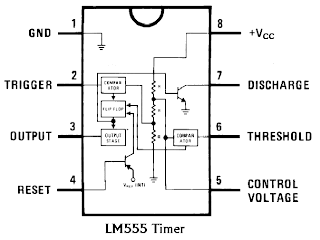Theory Timer 555
Timer 555 is a timer IC that works based on the RC circuit and the comparator is coupled with a digital component (R-Sflip-flop). The first 555 of the type manufactured by Signetics SE-555 working at -55 ° C to 125 ° C and the NE-555 working at 0 ° C-70 ° C. Then 555 is produced with different designs include the LM555, 556 (dual version), and LMC-555 (CMOS version). Timer 555 operates at +5 V dc power supply sd +18 V with temperature stability of 50ppm / ° C (0.005% / ° C). Output 555 can be a current sink / source up to 200mA. IC 555 is compatible with the components of TTL, CMOS op-amps, transistors and other types of linear ICs.
Timer 555 can operate either as a monostable or astable. The resulting square wave output can have a variation of duty cycle ranging from 50 - 99.9% and the frequency of less than 0.1 Hz up to more than 100KHz. 555 Series consists of two voltage comparators (COMP1 and COMP2), a control flip-flop RS (reset / set) that can be reset from outside via the pin 4, an inverting amplifier output (A1), and a discharge transistor (Q1). Kompartor second bias level determined by voltage divider resistors (Ra, Rb, and Rc) contained between Vcc and ground. Inverting input 2/3Vcc komparator1 given input and noninverting input from the given input komparator2 1/3Vcc. Monostable operation requires the input pulse triggers the PIN2 of IC 555. Input trigger voltage drop of more than +2 / 3Vcc toward the voltage is less than + Vcc / 3.
Monostable operation Timer 555
Monostable multivibrator (MMV), also called a one shot, producing a pulse output with a certain period when triggered by a pulse input. Output from Oneshot will instantly go 'high' following the trigger pulse (trigger) and will remain 'high' in accordance with its period. When the period had expired, the output will return 'low'. Outpt Oneshot will remain 'low' until there is another trigger. IC 555 can be operated as MMV by adding an appropriate external circuit.
Both internal comparator prasikap given voltage with a certain voltage level by voltage divider arranged series (Ra, Rb, Rc). Inverting input voltage up to 2/3Vcc komparator1 given, and the noninverting input voltage komparator2 given Vcc / 3. Tersebutlah voltage operation resulted in 555 both as a monostable or astable. External timing circuit (R1C1) connected between Vcc and noninverting input komparator1 through pin6. Pin7 also been linked with causing terhubungnya pin6 transistor to the capacitor C1. When the transistor is 'on', the resistance of the capacitor is so low that connect (short) through the relationship of CE transistor.
When 555 is connected to the source voltage, input voltage inverting komparator1 will receive registration 2/3Vcc and noninverting input voltage komparator2 would have amounted to Vcc / 3. This causes the RS flip-flop in a reset condition, so that its output Qnot 'high'. Therefore flip-flop connected to the output through an inverting amplifier pin3 (A1) then the output 555 'low'. In these conditions the capacitor charge (charging). Qnot in the 'high' cause transistor Q1 saturated, which means is connected to ground through a capacitor C1. So in this condition the capacitor to remove the charge (discharge) so that Vc = 0.
If PIN2 give trigger input, when pulsatrigger move towards less than 1/3Vcc voltage as shown in the picture, the noninverting input is more positive than the input komparator2 invertingnya, so that the output komparator2 be 'high'. At that time, FIP-flop in the set, so that the output Qnot her 'low' and keuaran 555 'high'. Because of its low Qnot output, means of transistors in the 'off'. Current flows from Vcc to ground through a capacitor C1. In other words, the capacitor re-charging. (Picture). Capacitor voltage will continue to rise until it reaches 2/3Vcc, at which time the output Vc = 2/3Vcc komparator1 be 'high' and cause the flip-flop is reset and the output 555 back to 'low'. The output 555 will remain until there is another trigger input.
All IC timers rely on an external capacitor to determine the interval of time off-on pulse output. The capacitor would require a certain time to charge or discharge through a resistor. Time can be explained and calculated from the resistance and capacity are given. Equation pulse period to 555 depending on the time required by the capacitor at the time of filling until it reaches 2/3Vcc voltage provided by the RC time constant. Thus, if the capacitor voltage e = E (1 - (-t/RC)), can be calculated time will enable the comparator threshold.











0 comments
Post a Comment